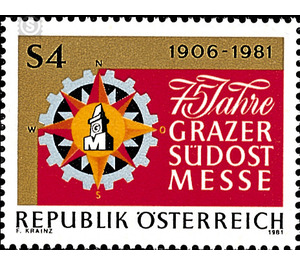75 years - Austria / II. Republic of Austria 1981 - 4 Shilling
Theme: Calender
| Country | Austria / II. Republic of Austria |
| Issue Date | 1981 |
| Face Value | 4.00 |
| Color | multi-colored red |
| Printing Type | Photogravure |
| Stamp Type | Commemorative |
| Item Type | Stamp |
| Chronological Issue Number | 1025 |
| Chronological Chapter | OOS-OE2 |
| SID | 310715 |
| In 67 Wishlists | |
The Grazer Südost-Messe celebrated its 75th anniversary in 1981. On September 29, 1906, the first autumn fair was held in Graz. It involved 123 exhibitors, 46 showmen, 24 innkeepers and 35 stall owners. In 1908, the jubilee of the emperor Franz Josef I was taken as an opportunity to organize an Emperor's Mass. This fair was one of the most glamorous in the history of Graz. More than 400,000 visitors came from all over the monarchy. After the First World War, the economy recovered only slowly. Only in the autumn of 1921 was it possible to hold a trade fair in the industrial hall in Graz. In 1928, in addition to the traditional autumn fair on the occasion of the 800th anniversary of the city of Graz, a spring fair was held. After the Second World War in 1948, a Grazer Herbstmesse took place again. Special efforts in the postwar period were aimed at intensifying economic relations with the southeastern neighboring countries, which is why the fair has been bearing the name "Grazer Südost-Messe" since 1960. In the period after 1960, the trade fair in Graz was the strongest. It developed into a multi-sector trade fair with strict technical separation.


